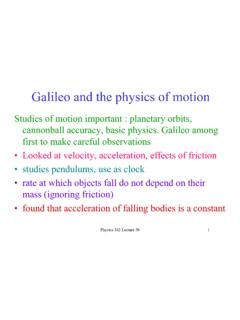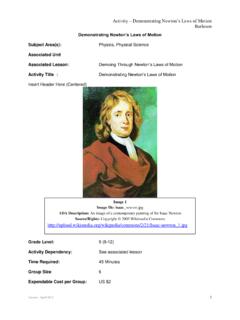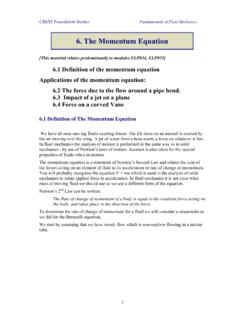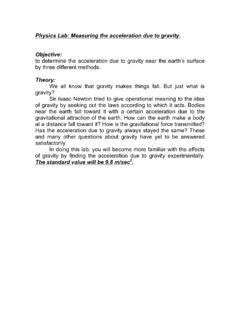Transcription of Newton's Laws of Motion Newton's First Law of Motion ...
1 newton s Notes 1 Newton's laws of Motion Newton's First Law of Motion Objects at rest stay at rest, Objects in Motion stay in Motion , Until something changes its Motion . Things continue doing what they are doing unless a force is applied to it. Objects have a natural tendency to resist change. This is INERTIA. Heavier objects (objects with more mass) are more difficult to move and stop. Heavier objects (greater mass) resist change more than lighter objects. Example: Pushing a bicycle or a Cadillac, or stopping them once moving. The more massive the object (more inertia) the harder it is to start or stop. The Cadillac has more of a tendency to stay stationary (or continue moving), and resist a change in Motion than a bicycle. Weight vs.
2 Mass Mass is the amount of matter. It is a measure of inertia. Weight of an object is a result of the Earth s attraction downward. Weight is a downward force. Example: An astronaut in space has the same mass as he does on earth while having different weights. This is because there is a difference in gravity . gravity affects weight, it does not affect mass. MASSES ALWAYS REMAIN THE SAME. Newton's Second Law of Motion : Force = mass x acceleration The acceleration of an object is: a) directly proportional to the net force acting on the object. b) in the direction of the net force. c) inversely proportional to the mass of the object. Let's see if this makes sense. If I push on a dresser from behind and push in a forward direction to slide it along the floor, it moves in the direction I push.
3 It starts from rest and moves. This is acceleration. If I decrease the mass of the dresser by removing the drawers, I can: 1. Move it faster (greater acceleration), because there is less mass, or 2. Push less to move it (use less force.) Force is measured in Newtons (N) 1 N = 1 Kg m/s2. (Force) = (mass) x (acceleration) 1 N = 1 apple, force is weight! Weight = mass x acceleration, or W = m x g (acceleration due to gravity ) Problem: What is my weight if my mass is kg (198 lbs)? Weight (Force) = mass x acceleration due to gravity Weight = kg x m/s2 Weight = 882 N or 882 kg m/s2 newton s Notes 2 gravity has an effect on an object in the vertical direction only. If I drop an object, its path follows directly toward the center of the earth.
4 For an object standing still, the acceleration due to gravity is still m/s2. On earth, normally we do not distinguish between mass and weight. Notice they have different units! Net Force Example: Tug of War The net force is 0. Equal forces in opposite directions. To refine the previous definition, to accelerate a mass, a NET force must be applied. Example: Sitting on a chair. You exert a downward force onto the chair. The chair exerts and equal and opposite force upward. Notice that you are not moving. There is no net force. The net force is 100N to the left. The greater force always overcomes the lesser force. In this case the rope accelerates to the left. What happens when acceleration is 0? The object is in equilibrium.
5 All forces cancel each other, thus the net force = 0. What if something is moving at a constant velocity? Is there acceleration? No! Ignoring friction, if something is moving at constant velocity there is no acceleration. In other words, no force is required to keep it moving. The object is moving without acceleration. Friction Friction is a force that acts in the direction opposite Motion which occurs between two objects in contact. What causes objects to stop moving? Friction Between objects (Brakes on a car get hot) Between air and the object (Stick your hand out of a moving car window) Efforts to reduce friction: Oil, grease, lubricants, Teflon oil additives Automobile aerodynamics, hydrodynamics, athletes (skiers, swimmers) What if we do not ignore friction, then if something is moving at a constant velocity, is it accelerating?
6 No! But we must apply a force to keep the object moving because friction is slowing down the object. Example: Sliding a table across the floor. I exert 100 N to the right. If the table doesn't move, the table exerts 100 N to the left. If I exert 200 N to the right, and it doesn't move, the table exerts 200 N to the left. If I exert 300 N to the right and it moves, then I have overcome the static frictional forces between the table and floor. L <-----|-----> R 100N 100N L <----------|-----> R 200N 100N newton s Notes 3 What happens when acceleration of an object is equal to the acceleration due to gravity ? FREE FALL! When the only force acting on an object is gravity (no air resistance) and falling toward the earth, then it is in free fall, a = g.
7 What happens when acceleration is less than g? NONFREE FALL. Objects of different masses falling in a vacuum will fall with the same acceleration. This was Galileo's thought experiment (see the Hammer and Feather video clip on the Resources link on this webpage). Objects falling through air do not fall at the same rate. Try a piece of paper and a wad of paper. The wad of paper falls with a greater acceleration because there is less air resistance. Air resistance is friction, thus it acts in the direction opposite to Motion . Objects fall downward, air pushes upward. Air resistance depends on: 1. size of falling object (how much air must it move through) 2. speed of falling object (how much air it encounters per second) Objects of equal mass different sizes In comparing the Motion of the paper helicopter and the paper ball, both pieces of paper accelerate initially, but the helicopter falls at a constant velocity sooner since the downward force equals the upward force sooner.
8 This constant velocity is called terminal velocity. Terminal velocity is the speed at which the downward force (weight) equals the upward force (air friction or drag). The object continues to fall, but with NO ACCELERATION! Notice that there is no net force if the upward and downward forces are equal. Objects of equal size different masses. Consider a hollow ball and a ball filled with lead. As the balls accelerate, each increases its velocity, each encounter the same air resistance. The upward force compared to the downward force of the light ball is greater than the heavier ball. Both encounter the same air resistance, but, the heavier ball has a greater downward force which overcomes the upward force of the air.
9 The heavier ball will still reach a t erminal velocity. But, it will accelerate longer than the hollow ball, and its terminal velocity will be greater. newton s Third Law of Motion Whenever an object exerts a force on a second object, the second object exerts an equal and opposite force on the First . An apple is growing in a tree. The force exerted on the apple by the earth and the force exerted by the apple on the earth are equal. Action/Reaction: For every force there is an equal but opposite force. The Bug & Car: When the juicy Junebug splatters on your windshield, the car and the bug feel the same force. The mass of the bug is less so therefore the acceleration of the bug (change in direction and speed) is greater for the bug than your car.
10 Mass and acceleration are inversely proportional. newton s Notes 4 Problems: 1. What is the weight of an object (in Newtons) which has a mass of kg? 2. What force must I exert to lift the above object off the ground? 3. A car with a mass of 1200 kg has an engine that can deliver a constant force of 25,000N. What would be the acceleration of the car? 4. If I installed the same motor in a car with a mass of 1000 kg, would the car have a greater acceleration? What is the acceleration now? Answers: (1) 448 N; (2) 448 N; (3) 21 m/s2; (4) yes, 25 m/s2.












